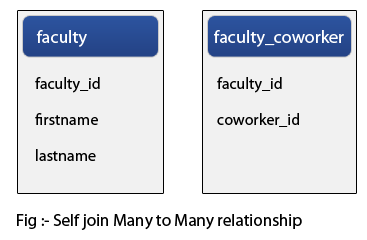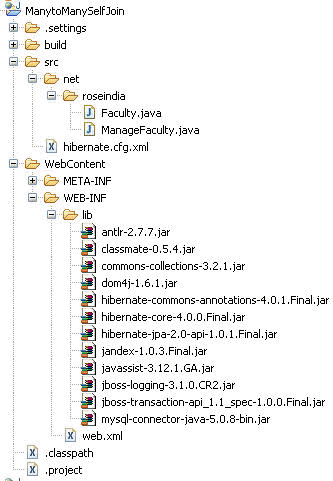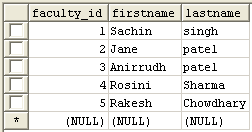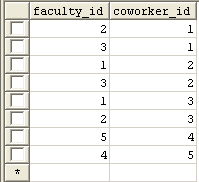Hibernate Many to Many Self Join using Annotations
In this section, you will learn how to do many to many self join using Annotations in Hibernate.
In many to many self join table, a table is related to itself using bridge table. In the below example, faculty table has many to many relationship where every faculty is coworker and every coworker is faculty. The faculty table has self join many to many relationship using faculty_coworker.

The project hierarchy is given below :

Database table query :
The query used to create a faculty table is given below :
CREATE TABLE `faculty` ( `faculty_id` bigint(10) NOT NULL auto_increment, `firstname` varchar(50) default NULL, `lastname` varchar(50) default NULL, PRIMARY KEY (`faculty_id`) ) ENGINE=InnoDB DEFAULT CHARSET=latin1
The query used to create a faculty_coworker table is given below :
CREATE TABLE `faculty_coworker` ( `faculty_id` bigint(10) NOT NULL, `coworker_id` bigint(10) NOT NULL, PRIMARY KEY (`faculty_id`,`coworker_id`), KEY `FK_coworker` (`coworker_id`), CONSTRAINT `FK_coworker` FOREIGN KEY (`coworker_id`) REFERENCES `faculty` (`faculty_id`), CONSTRAINT `FK_faculty` FOREIGN KEY (`faculty_id`) REFERENCES `faculty` (`faculty_id`) ) ENGINE=InnoDB DEFAULT CHARSET=latin1
hibernate.cfg.xml( /src/hibernate.cfg.xml )
<?xml version='1.0' encoding='utf-8'?> <!DOCTYPE hibernate-configuration PUBLIC "-//Hibernate/Hibernate Configuration DTD 3.0//EN" "http://hibernate.sourceforge.net/hibernate-configuration-3.0.dtd"> <hibernate-configuration> <session-factory> <!-- Database connection settings --> <property name="connection.driver_class">com.mysql.jdbc.Driver</property> <property name="connection.url">jdbc:mysql://192.168.10.13:3306/anky</property> <property name="connection.username">root</property> <property name="connection.password">root</property> <property name="connection.pool_size">1</property> <property name="dialect">org.hibernate.dialect.MySQLDialect</property> <property name="current_session_context_class">thread</property> <property name="cache.provider_class">org.hibernate.cache.NoCacheProvider</property> <property name="show_sql">true</property> <property name="hbm2ddl.auto">validate</property> <mapping class="net.roseindia.Faculty"/> </session-factory> </hibernate-configuration>
Faculty.java( /src/net/roseindia/Faculty.java )
package net.roseindia;
import java.util.*;
import javax.persistence.*;
@Entity
@Table(name="faculty")
public class Faculty {
@Id
@Column(name="faculty_id")
@GeneratedValue
private Long facultyId;
@Column(name="firstname")
private String firstname;
@Column(name="lastname")
private String lastname;
@ManyToMany(cascade={CascadeType.ALL})
@JoinTable(name="faculty_coworker",
joinColumns={@JoinColumn(name="faculty_id")},
inverseJoinColumns={@JoinColumn(name="coworker_id")})
private Set<Faculty> coworkers = new HashSet<Faculty>();
@ManyToMany(mappedBy="coworkers")
private Set<Faculty> colleagues = new HashSet<Faculty>();
/**
* @param firstname
* @param lastname
*/
public Faculty(String firstname, String lastname) {
this.firstname = firstname;
this.lastname = lastname;
}
/**
* @return the facultyId
*/
public Long getFacultyId() {
return facultyId;
}
/**
* @param facultyId the facultyId to set
*/
public void setFacultyId(Long facultyId) {
this.facultyId = facultyId;
}
/**
* @return the firstname
*/
public String getFirstname() {
return firstname;
}
/**
* @param firstname the firstname to set
*/
public void setFirstname(String firstname) {
this.firstname = firstname;
}
/**
* @return the lastname
*/
public String getLastname() {
return lastname;
}
/**
* @param lastname the lastname to set
*/
public void setLastname(String lastname) {
this.lastname = lastname;
}
/**
* @return the coworkers
*/
public Set<Faculty> getCoworkers() {
return coworkers;
}
/**
* @param coworkers the coworkers to set
*/
public void setCoworkers(Set<Faculty> coworkers) {
this.coworkers = coworkers;
}
/**
* @return the colleagues
*/
public Set<Faculty> getColleagues() {
return colleagues;
}
/**
* @param colleagues the colleagues to set
*/
public void setColleagues(Set<Faculty> colleagues) {
this.colleagues = colleagues;
}
}
ManageFaculty.java( /src/net/roseindia/ManageFaculty.java)
package net.roseindia;
import org.hibernate.Session;
import org.hibernate.SessionFactory;
import org.hibernate.cfg.Configuration;
import org.hibernate.service.ServiceRegistry;
import org.hibernate.service.ServiceRegistryBuilder;
public class ManageFaculty {
private static SessionFactory sf;
private static ServiceRegistry serviceRegistry;
public static void main(String[] args) {
try {
Configuration configuration = new Configuration();
configuration.configure();
serviceRegistry = new ServiceRegistryBuilder().applySettings(
configuration.getProperties()).buildServiceRegistry();
sf = configuration.buildSessionFactory(serviceRegistry);
} catch (Throwable ex) {
System.err.println("Failed to create sessionFactory object." + ex);
throw new ExceptionInInitializerError(ex);
}
System.out.println("********Hibernate Many to Many Self Join mapping using Annotations*******");
Session session = sf.openSession();
session.beginTransaction();
Faculty f1=new Faculty("Sachin","singh");
Faculty f2=new Faculty("Anirrudh","patel");
Faculty f3=new Faculty("Jane","patel");
Faculty f4=new Faculty("Rosini","Sharma");
Faculty f5=new Faculty("Rakesh","Chowdhary");
f1.getCoworkers().add(f2);
f1.getCoworkers().add(f3);
f2.getCoworkers().add(f1);
f2.getCoworkers().add(f3);
f3.getCoworkers().add(f1);
f3.getCoworkers().add(f2);
f4.getCoworkers().add(f5);
f5.getCoworkers().add(f4);
session.save(f1);
session.save(f2);
session.save(f3);
session.save(f4);
session.save(f5);
session.getTransaction().commit();
session.close();
}
}
OUTPUT
********Hibernate Many to Many Self Join mapping using Annotations******* Hibernate: insert into faculty (firstname, lastname) values (?, ?) Hibernate: insert into faculty (firstname, lastname) values (?, ?) Hibernate: insert into faculty (firstname, lastname) values (?, ?) Hibernate: insert into faculty (firstname, lastname) values (?, ?) Hibernate: insert into faculty (firstname, lastname) values (?, ?) Hibernate: insert into faculty_coworker (faculty_id, coworker_id) values (?, ?) Hibernate: insert into faculty_coworker (faculty_id, coworker_id) values (?, ?) Hibernate: insert into faculty_coworker (faculty_id, coworker_id) values (?, ?) Hibernate: insert into faculty_coworker (faculty_id, coworker_id) values (?, ?) Hibernate: insert into faculty_coworker (faculty_id, coworker_id) values (?, ?) Hibernate: insert into faculty_coworker (faculty_id, coworker_id) values (?, ?) Hibernate: insert into faculty_coworker (faculty_id, coworker_id) values (?, ?) Hibernate: insert into faculty_coworker (faculty_id, coworker_id) values (?, ?)
You will get following record in the faculty table :

In the faculty_coworker table, you will get the following record :

